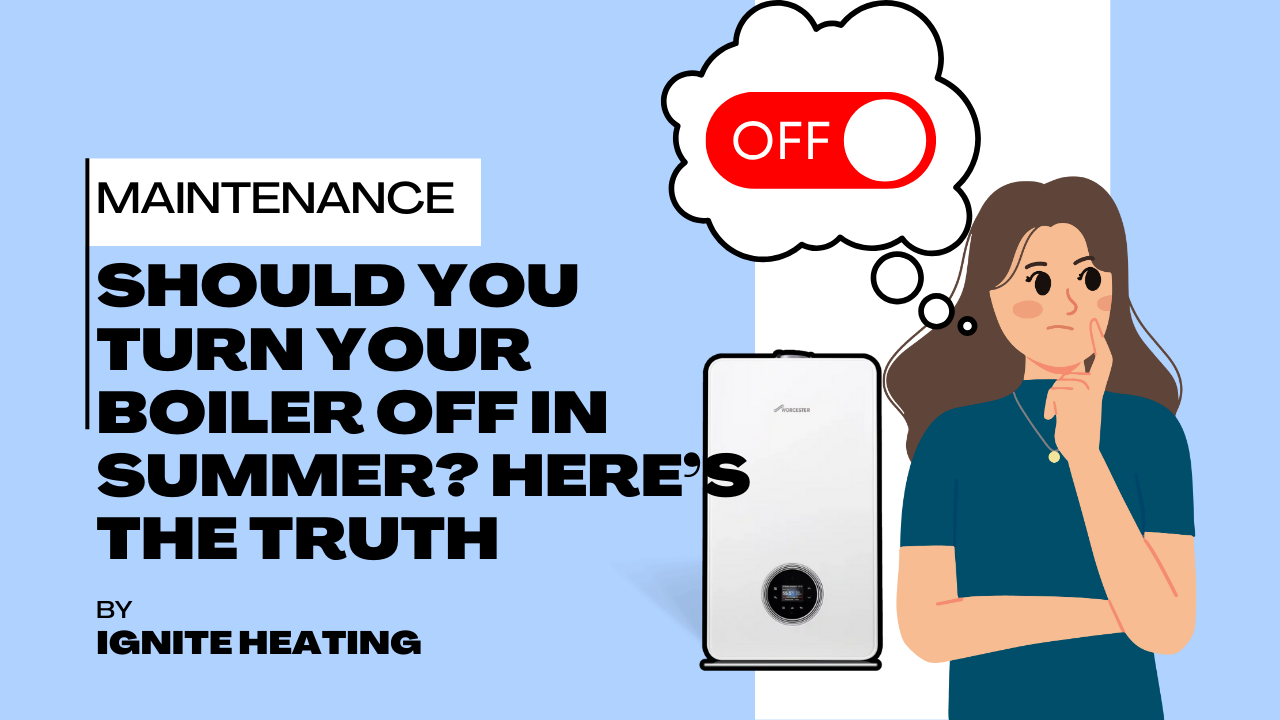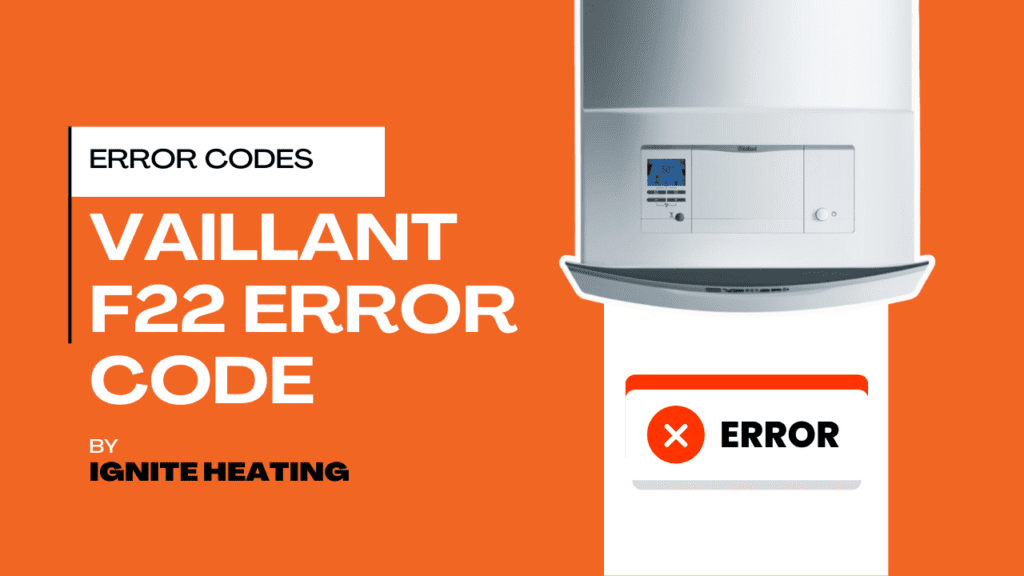
Should You Turn Your Boiler Off in Summer? Here’s the Truth.
Search Should You Turn Your Boiler Off in Summer? Here’s the Truth. Summer’s here finally. The sun’s shining (most days),

If you have a Vaillant and you are experiencing no hot water when you’re going to wash your dishes or jumping in the shower then you might want to keep reading….
Before you panic or start worrying about costly repairs, take a deep breath—the F22 fault is one of the most common and often fixable boiler issues. While it can be frustrating, in most cases, it’s simply a sign of low pressure in your heating system, which can be resolved in just a few simple steps. However, if the issue keeps returning, it could indicate a deeper problem that needs attention.
In this guide, we’ll take you through everything you need to know about the Vaillant F22 fault code, including:
✅ What the error code means and why your boiler has shut down
✅ The common causes of low boiler pressure (and how to spot them)
✅ Step-by-step solutions to get your heating and hot water running again
✅ When to DIY and when to call in a Gas Safe engineer
If you want to get to the bottom of your boiler issues and prevent the F22 error from happening again, keep reading we’ve got you covered. 🚀
The most common reasons for the F22 fault code include:
Even a small leak in a radiator, pipe, or boiler component can cause pressure to drop over time.
Damp patches on walls or ceilings, especially near radiator pipes.
Water pooling near the boiler or under radiators.
Rust or corrosion around pipe joints.
Check all radiators and pipework for visible leaks.
Call an engineer to tighten any loose connections
If you find a leak, contact a Gas Safe engineer to repair it.
If you’ve bled your radiators recently, this could be why your boiler pressure is low. Bleeding radiators removes trapped air, but it also reduces system pressure as water escapes.
Check the boiler’s pressure gauge—if it’s below 1.0 bar, the system needs refilling (to around 1.5 bar when cold).
Top up the pressure using the boiler’s filling loop (see instructions below).
The filling loop is a small hose connected to the pipes under the boiler connecting the cold and central heating pipe or is sometimes a fitting underneath the boiler which connects the cold and central heating valve, used to add water to the system. If it’s left slightly open, it can cause pressure loss over time.
Check that both valves on the filling loop are fully closed.
If the loop is faulty or leaking, it may need replacing.
The boiler’s pressure sensor detects water pressure and triggers the F22 fault if it reads low levels. If the sensor is faulty, it may give incorrect readings, even if the pressure is normal.
Try repressurising the boiler (see steps below).
If the error persists despite normal pressure levels, an engineer may need calling to replace the sensor.
If you’ve identified that low pressure is causing the issue, the best way to reset your boiler is by topping up the pressure. Here’s how to do it safely:
Locate the pressure gauge on your boiler. It should ideally be between 1.0 and 1.5 bar when cold.
If it’s below 1.0 bar, the system needs repressurising.
If it’s above 2.5 bar, the pressure may be too high (in which case, bleeding a radiator can help reduce it). To find out how to bleed a radiator, head to our other blog.
To increase the pressure, follow these steps:
Turn off the boiler and allow it to cool.
Locate the filling loop underneath the boiler (a flexible silver small hose sometimes a fitting underneath the boiler).
Slowly turn the valves to open the loop, allowing water to enter the system.
Watch the pressure gauge rise to between 1.0 and 1.5 bar.
Once the correct pressure is reached, close both valves fully.
Restart the boiler and check if the F22 error has cleared.
💡 If the pressure drops again within a few hours or days, this indicates a bigger issue, such as a leak or faulty part.
If your boiler continues to lose pressure or displays the F22 fault code repeatedly, it’s best to call a Gas Safe registered engineer.
Call an engineer if:
You can’t find or fix a leak in the system.
The filling loop doesn’t work or leaks.
The pressure sensor gives false readings (indicating a fault).
The issue keeps returning despite re-pressurising the boiler.
Experiencing the F22 fault code can be frustrating, especially if it happens repeatedly. While repressurising the system is a quick fix, it’s important to address the underlying causes of pressure loss to prevent the issue from recurring. Here’s how you can keep your boiler pressure stable and avoid future faults.
One of the main causes of low boiler pressure is a leak somewhere in the system. Even a small, slow leak can gradually cause pressure to drop over time.
Inspect radiators and pipework – Look for damp spots, water stains, or small drips around radiator valves and pipe joints.
Check the boiler itself – Look underneath for puddles of water or signs of corrosion around connections.
Monitor ceilings and walls – If pipes are hidden behind walls or under floors, you might see damp patches or discoloration in these areas.
Listen for unusual sounds – A hissing sound near a pipe or radiator could indicate a small leak.
Bleeding radiators is essential to remove trapped air, which can cause cold spots and uneven heating. However, when you bleed a radiator, water is released from the system, which lowers the boiler pressure.
Before bleeding, check the boiler’s pressure gauge.
Slowly bleed one radiator at a time using a bleed key, only releasing enough air to restore even heating.
After bleeding, check the pressure gauge again—if it’s below 1.0 bar, you’ll need to top up the pressure using the filling loop.
Regular servicing is one of the best ways to prevent pressure loss and avoid the F22 fault code. A Gas Safe registered engineer will check for leaks, test pressure components, and ensure the system is in top condition.
Checking the expansion vessel and pressure relief valve—faulty parts here can cause pressure loss.
Inspecting pipework and radiators for leaks.
Ensuring the filling loop is correctly closed to prevent slow pressure drops.
Checking for corrosion inside the boiler and heating system, which can lead to leaks over time.
RA simple yet effective way to prevent unexpected pressure loss is by regularly checking your boiler’s pressure gauge.
Once a month as part of routine maintenance.
Before and after bleeding radiators to ensure pressure stays within the correct range.
After servicing or repairs to confirm everything is functioning properly.
Between 1.0 and 1.5 bar when the boiler is cold.
It may rise slightly when the heating is on, but should not exceed 2.5 bar.
Check the expansion vessel regularly – If it loses air pressure, the boiler pressure may drop too.
Ensure the filling loop is properly closed – A slightly open filling loop can lead to slow but continuous pressure loss.
Keep an eye on external pipes in winter e.g. pipes in attic space – Frozen pipes can lead to pressure-related issues inside the boiler.
The F22 fault code on a Vaillant boiler indicates low water pressure in your heating system. Boilers require a certain amount of pressure to function properly(normally at least 0.5 bar), and if the pressure drops too low, the boiler will shut down as a safety precaution.
Your heating and hot water may stop working.
The pressure gauge on the boiler will show a reading below 0.5 bar (low pressure).
The boiler’s internal sensors detect the low pressure and prevent operation to avoid damage.
The good news? Low pressure is a relatively easy issue to fix in most cases. However, if the pressure keeps dropping, it could indicate a bigger underlying problem.
The good news? Fixing a Vaillant F22 fault will often cost you nothing at all. Unlike more serious boiler problems that require expensive parts or professional repairs, the F22 error is usually caused by low system pressure, which is something most homeowners can fix themselves.
If the issue is simply low boiler pressure, you can repressurize the system yourself by following the steps outlined in this guide. Topping up the pressure using the filling loop is quick, straightforward, and doesn’t require any special tools or expertise.
✔ Cost: £0 – Just a few minutes of your time!
While most F22 faults can be resolved with a simple pressure top-up, in some cases, there may be underlying issues causing the pressure drop. If this is the case, you may need to call a Gas Safe engineer, which can incur costs depending on the problem:
Potential Cause | DIY Fix? | Estimated Cost |
Low boiler pressure | ✅ Yes | £0 (DIY fix) |
radiator/pipework leak | ❌ No | £80-£250 for engineer and repair |
Broken expansion vessel | ❌ No | £100-£400 (replacement) |
Broken pressure sensor | ❌ No | £80-£250 (replacement) |
Persistent pressure loss | ❌ No | Varies – If multiple leaks or corroded parts need replacing |
To keep your boiler running smoothly and avoid costly repairs in the future, consider these tips:
✔ Check boiler pressure regularly – Catch drops in pressure early.
✔ Look for leaks around radiators and pipework – Address small leaks before they become bigger problems.
✔ Service your boiler annually – A Gas Safe engineer can check for early signs of wear and tear.
The F22 fault code on a Vaillant boiler is a common low-pressure issue that can usually be fixed by repressurizing the system. In most cases, it’s caused by minor leaks, radiator bleeding, or an open filling loop. However, if the issue keeps occurring, it’s important to get a Gas Safe engineer to investigate potential leaks, pressure sensor faults, or boiler component failures.
🔧 Need help with a Vaillant F22 fault? Contact a heating expert today for fast, professional repairs!

Search Should You Turn Your Boiler Off in Summer? Here’s the Truth. Summer’s here finally. The sun’s shining (most days),

Search Should I Upgrade My Central Heating System Before Winter? Winter in the UK can be brutal, with freezing mornings,
© 2024 Ignite Heating. All rights reserved